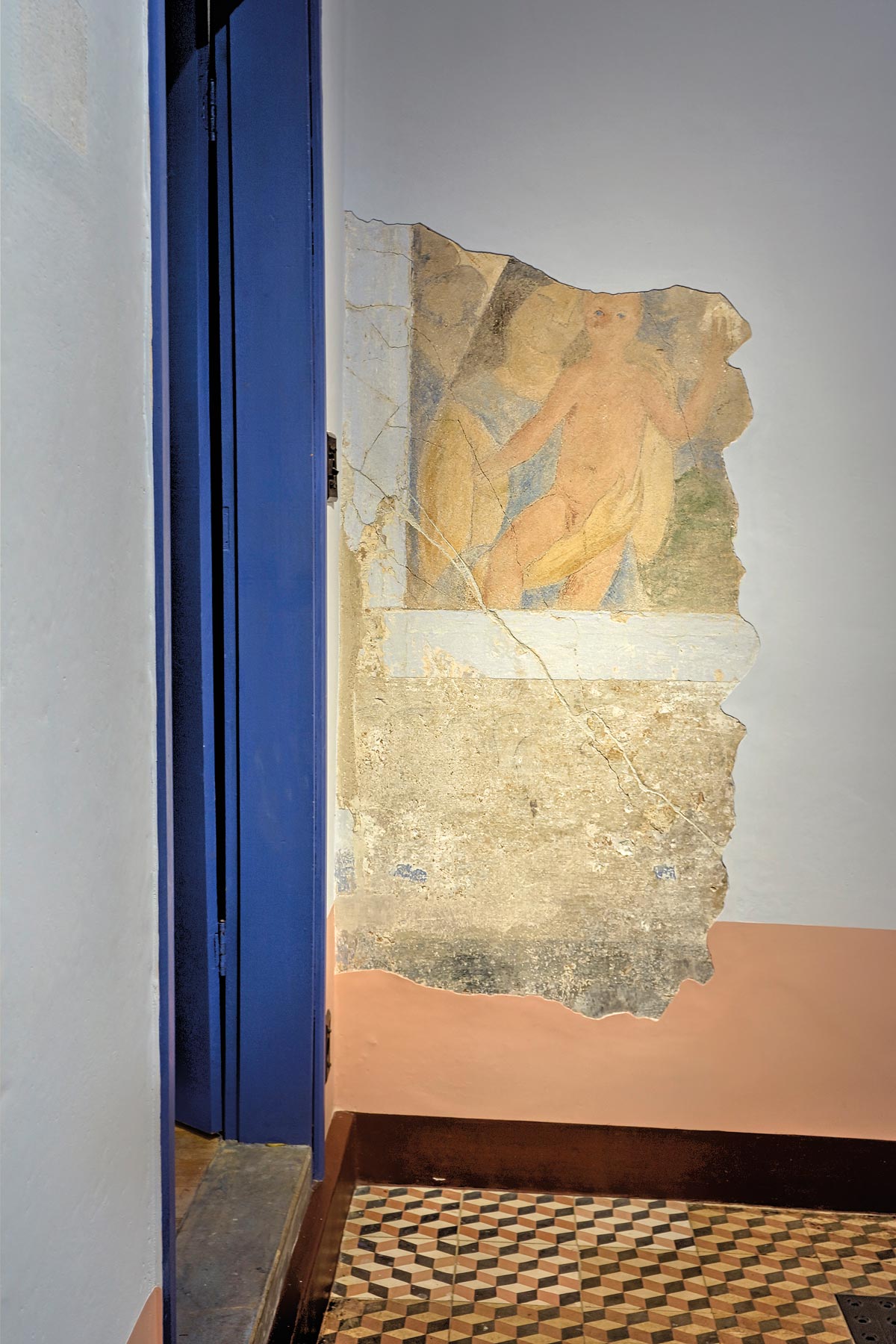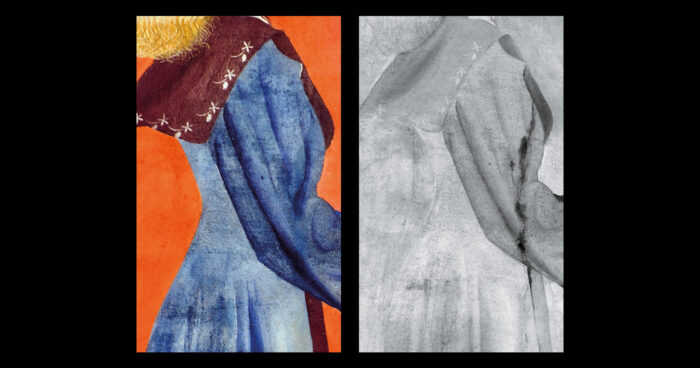The taking of images at different wavelengths, such as infrared, ultraviolet, and X-ray, has brought to light the nuances of the creative process of Candido Portinari (1903–1962). In collaboration with restorers and museologists, the team of the nuclear physicist Márcia Rizzutto, of the University of São Paulo (USP), used different physico-chemical analysis techniques to study the painter’s works and, in some cases, succeeded in pointing out the hidden strokes that had been sketched and later covered up by layers of paint by the artist himself. These findings are the result of studies of paintings from two collections of Portinari’s works located in São Paulo: the murals in the Casa de Portinari Museum in Brodowski, the painter’s native city, and the sacred canvas collection in the Senhor Bom Jesus da Cana Verde Sanctuary, the main church of Batatais. The studies also refined our scientific knowledge of the chemical composition of the painter’s preferred colors called the pigment palette.
Hidden details in a mural
Images of different wavelengths reveal cracks and how the painter created the figure of Saint Elizabeth
The most interesting discoveries came from analyses of murals in a small room called the Chapel of Nonna, located in the former home of the Portinari family, which today is a museum and belongs to the Department of Culture of the State of São Paulo. The chapel exhibits sacred images and images of saints with physiognomies inspired by members of the artist’s family and his friends. The chapel was built at the beginning of the 1940s so that Portinari’s grandmother Pelegrina, who was sick at the time, could pray without having to go to church. To the left of the entrance, there is an eye-catching mural that measures 1.8 meters (m) by 1.6 m and that portrays the visit of Our Lady to Saint Elizabeth, whose faces were designed, respectively, based on the features of Portinari’s sister, Olga, and his wife, Maria Martinelli (1912–2006).
Rizzutto produced infrared images of Saint Elizabeth’s figure and claimed that through the addition of pencil strokes, the painter corrected the drawing in three places: the contour of the eyebrow, the shape of her waist (which was reduced in comparison to the initial draft), and her fingers. “Referred to as ‘pentimento,’ the pencil marks show the artist’s dissatisfaction, who changed his mind during the creation of the artwork and altered the figures in the painting,” comments the researcher and manager of the Center for Applied Physics Research on the Study of Artistic Heritage and History (NAP-FAEPAH) at USP. Infrared images are commonly used to investigate the creative process of painters, as the images can detect pencil sketches covered by paint.
These details of the way that Portinari worked are invisible when the mural is observed or photographed in conventional ways using visible light. The images rendered using infrared and ultraviolet light also show that below the layers of color that give shape to the saint’s face, there are two large cracks in the wall that are imperceptible to the naked eye that may have arisen due to instabilities in the structure and that were later corrected. Photos using visible light wavelengths can also be useful for highlighting unsuspected nuances of paintings when taken with a low-angle flash. In such cases, the light illuminating a painting should be placed at a very slight angle, called low-angle or tangential, in relation to the artwork’s position. In this way, this type of photography can accentuate the possible disparities in the surface and outline the quantity and markings of the strokes.
In 2018, a study discovered that Pablo Picasso hid a newspaper article in one of his paintings
As knowledge was gained of the painter’s palette and the hidden markings that his working method tended to make, Rizzutto built a database of the chemical elements present in the paint of Portinari’s works. Using the X-ray fluorescence technique, where each chemical element emits a particular pattern of this type of radiation, she mapped the pigments that give color to the artist’s paintings. According to the physicist, the green used by Portinari was created by using chromium or a mixture of cobalt and cadmium. In the white pigment, zinc was predominant. The composition of the reds varied according to the tone: in general, there was iron, manganese with iron, cadmium with selenium and even mercury. The yellows were a blend of cadmium and, in some cases, even lead. “Portinari was a modern artist who already used a lot of paint bought in tubes. However, he worked with many color gradations through blending and had a preference for some combinations,” says Rizzutto.
Given this knowledge, the physicist took on an even more challenging task in another room at the Casa de Portinari Museum: to determine whether the painter was the creator of a mural that was partially covered with plaster and rediscovered a few years ago. The painting is a fragment of Our Lady with a Child, which originally adorned the wall on the porch of the house. During one of the many changes that Portinari made to the house, the mural was covered up by plaster. “He extended the porch to become the house’s main living room and, in the renovation process, this painting was covered up,” says Angélica Fabbri, director of the museum. “Some years ago, our restorer Julio Moraes found a blue dot and began peeling away the wall until the painting appeared.”
As there is no formal registration of the work, and as it is known that Portinari sometimes invited friends to paint in his home, it has not yet been possible to attribute the painting to the artist from the city of Brodowski. “The painting has some elements that resemble one of Portinari’s works,” confirms Rizzutto. Among them is the use of a type of contour in the figures that is similar to that of the other murals in the museum. For now, however, the authorship of the painting has yet to be confirmed.

Pedro Campos
A canvas with 25 superimposed colors used to study the effects of the superimposition of paints
Pedro CamposThe chemical analysis of pigments and multispectral images of works of art are common procedures in the grand museums of Europe and the United States. At the Pinacoteca of the State of São Paulo, for example, various works undergo this type of a procedure carried out by the team from the Institute of Physics under the supervision of art experts. The studies frequently reveal that the greatest painters did not hesitate to reuse canvases previously used for less important works or sketches to give life to a new painting.
Last year, John Delaney, image scientist for the National Gallery of Art in Washington, United States, showed that the paint on the canvas Mulher com criança perto do mar (Woman with a child by the sea), painted in 1902 by Pablo Picasso (1881–1973) and today the property of a museum in Japan, hid two secrets: one relatively common, the existence of a former drawing by new pigments; and an unusual one, a fragment of a text from the Parisian newspaper Le Journal (January 18, 1902 edition). “In order to verify if our focus was right, I first pointed the camera at the face of the woman and, to my surprise, I immediately saw the newspaper text in her face,” Delaney said in a media release, having used X-ray images and infrared images in his analysis.
In Brazil, the works made in the Brodowski home were not the first that challenged Rizzutto to study the production of Portinari. In 2014, the physicist’s team, which had already analyzed the works of Alfredo Volpi (1896–1988), Di Cavalcanti (1897–1976), and Anita Malfatti (1889–1964), was sought out to examine the painter’s works that are in the main church of Batatais. The researcher was invited, not only for her experience with this type of study, but also for another reason: she has a mobile laboratory and can transport her analysis equipment to the places where the works of art are situated. The main church has 27 sacred paintings made by Portinari. “When he donated the works, Portinari placed a condition that they could not leave the church under any circumstances,” recalls restorer Florence White de Vera, who had worked on the conservation project of the sanctuary’s collection.

Pedro Campos
A mural discovered in the Casa de Portinari Museum in Brodowski is being studied to determine the author
Pedro CamposOne of the physicist’s key objectives was to understand why the blue used by Portinari was deteriorating in a strange way. “When we applied material to do a superficial cleaning, the painting became opaque,” explains White de Vera. The blue used by Portinari is comprised of cobalt or cobalt with tin, mixed with a binder, a substance that holds the pigment particles together. Rizzutto collected a blue-pigmented shaving that had fallen off of a canvas and took it for analysis, some of which was carried out at the Brazilian Synchrotron Light Laboratory in Campinas. “In November of last year, we finally concluded that the whitening is caused by the breakdown of the binder, and not of the pigment itself,” says Rizzutto.
Studying pigments superimposed on a canvas is one of the greatest challenges faced by researchers. Some X-ray and infrared imaging techniques have the capacity to identify superimposed works, but the analysis of colors is problematic. It is not always possible to distinguish in the study results if the color is on top of or below the overlay. In order to lessen this limitation, researchers of NAP-FAEPAH decided to produce paints with superimposed pigments to serve as a benchmark.
Geologist and restorer Eva Kaiser Mori, who did her master’s thesis under Rizzutto’s guidance, painted a standard canvas where a set of 25 pigments were superimposed, resulting in 625 different combinations. “This type of analysis can be used to determine the thickness of a layer of superimposed paint on a canvas and thus discover whether it was modified or falsified,” explains Mori. The characteristics of the pigments on the reference painting were described in an article published on November 20, 2018, in the magazine X-Ray Spectrometry, primarily authored by the physicist Daniela Balbino from the Federal University of Sergipe (UFS).
Published in February 2019
Republish



